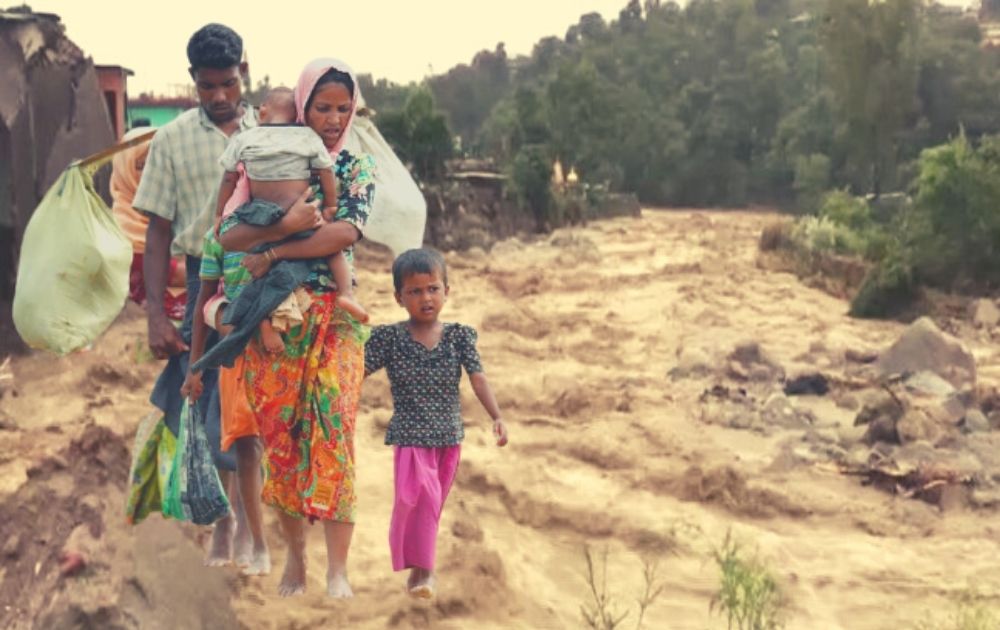
Image Credit: ANI, Since Independence
As Extreme Weather Events Rise, More People Are Being Displaced
Writer: Madhusree Goswami
A mountain girl trying to make it big in the city. She loves to travel and explore and hence keen on doing on-ground stories. Giving the crux of the matter through her editing skills is her way to pay back the journalism its due credit.
India, 29 July 2021 12:50 PM GMT
Editor : Ankita Singh |
A literature lover who likes delving deeper into a wide range of societal issues and expresses her opinions about the same. Keeps looking for best-read recommendations while enjoying her coffee and tea.
Creatives : Madhusree Goswami
A mountain girl trying to make it big in the city. She loves to travel and explore and hence keen on doing on-ground stories. Giving the crux of the matter through her editing skills is her way to pay back the journalism its due credit.
Climate change is creating more refugees than other conflicts. In 2020 in India, 3,856,000 people were displaced by environmental disasters, 989 times more than the 3,900 people displaced by conflicts.
As glaciers melt and the Earth becomes hotter by the day, there is no denying the fact that climate change is here. From record-breaking heatwaves in the United States of America and Canada last month to catastrophic flooding in Germany and China this month, the effects are becoming all too apparent.
When such disasters strike, it always leads to people being displaced and loss of livelihoods. According to data by Internal Displacement Monitoring Centre (IDMC), in 2020 in India, 3,856,000 people were displaced by environmental disasters, 989 times more than the 3,900 people displaced by conflicts.
Disaster Displacements Hit Record High In South Asia
South Asia, where nearly a quarter of the world's population resides, accounted for almost one-third of the world's new disaster displacements in 2020. Around 9.2 million displacements were recorded in the region. Cyclone Amphan alone triggered 5 million evacuations across Bangladesh, India, Myanmar and Bhutan in May 2020, making it the largest disaster displacement event of the year globally. In India, it triggered more than 2. million evacuations. The Sunderbans is home to the only mangrove forests where tigers. These forests have been depleting alarmingly, thanks to climate change. Between 986 to 2012, 124.418 sq. km. mangrove forest cover has been lost in the region.
According to the Global Climate Risk Index 2021, in 2019 India remained seventh on the list of the most affected countries by extreme weather events. Within India, West Bengal is one of the most climatically vulnerable states of India, with a history of a high number of severe cyclones in the Bay of Bengal coast, severe thunderstorms, a high sea-level rise and projected flood risk. These observations were pointed out in India's first official climate assessment report.
Who Are Climate Refugees?
The term "climate refugee" was first coined to describe the increasing large-scale migration and cross-border mass movements of people that were partly caused by such weather-related disasters. In April, the United Nations High Commissioner for Refugees (UNHCR) released data showing that the number of people displaced by climate change-related disasters since 2010 has risen to 21.5 million.
Globally, while 7.8 million people are displaced today, and despite climate refugees being three times more than conflict refugees (documented by the IDMC since 2008), the Office of the United Nations High Commissioner for Human Rights (UNHCR) has never granted refugee status to a single climate displaced person. The post World War II definition of a 'refugee' (still in use) does not include the millions forced to migrate because of hurricanes, wildfires or rising sea levels.
With no legal safeguards protecting such people, they are indeed vulnerable. Laws should be formulated to uphold their rights.
Also Read: COVID-19: Serosurvey Shows 44% Of Kerala's Population Infected, 79% In Madhya Pradesh
 All section
All section














